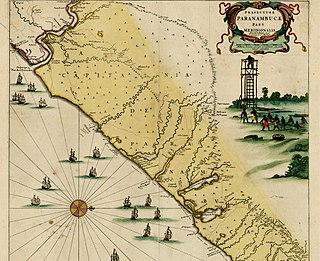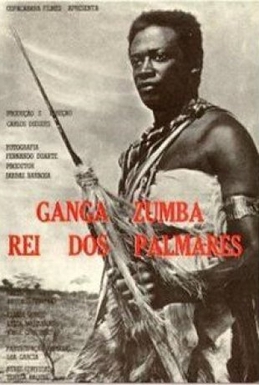
A quilombo is a Brazilian hinterland settlement founded by people of African origin, and others sometimes called Carabali. Most of the inhabitants of quilombos, called quilombolas, were maroons, a term for escaped slaves.

Zumbi, also known as Zumbi dos Palmares, was a Brazilian quilombola leader and one of the pioneers of resistance to slavery of Africans by the Portuguese in colonial Brazil. He was also the last of the kings of the Quilombo dos Palmares, a settlement of Afro-Brazilian people who liberated themselves from enslavement in the present-day state of Alagoas, Brazil. He is revered in Afro-Brazilian culture as a symbol of African freedom.

Palmares, or Quilombo dos Palmares, was a quilombo, a community of escaped slaves and others, in colonial Brazil that developed from 1605 until its suppression in 1694. It was located in the captaincy of Pernambuco, in what is today the Brazilian state of Alagoas. The quilombo was located in what is now the municipality of União dos Palmares.
Nganga Nzumba was the first leader of the massive runaway slave settlement of Quilombo dos Palmares, or Angola Janga, in the present-day state of Alagoas, Brazil. Zumba was enslaved and escaped bondage on a sugar plantation and eventually rose to the position of highest authority within the kingdom of Palmares, and the corresponding title of Ganga Zumba.

União dos Palmares is a municipality located in the Brazilian state of Alagoas. Its population was 65,790 (2020) and its area is 428 km². Surrounding agricultural land is largely dedicated to sugar cane and cattle. At one time, when the city was an active rail stop with regular passenger service, it was named simply União due to its rail junction joining Alagoas and Pernambuco. The name was changed in 1944 to reflect its historic significance. The city is increasingly seeing domestic and foreign tourist drawn by historical and natural features that are now protected in Parque Nacional Serra da Barriga and Parque Memorial Quilombo dos Palmares.

A quilombola is an Afro-Brazilian resident of quilombo settlements first established by escaped slaves in Brazil. They are the descendants of Afro-Brazilian slaves who escaped from slave plantations that existed in Brazil until abolition in 1888. The most famous quilombola was Zumbi and the most famous quilombo was Palmares. Many quilombolas live in poverty.

Quilombo is a 1984 Brazilian drama film directed by Carlos Diegues. It was entered into the 1984 Cannes Film Festival. The film is based on the history of the Quilombo dos Palmares, a community of escaped slaves that numbered in the thousands during the 17th century in north-eastern Brazil.
Maria Firmina dos Reis was a Brazilian author. She is considered Brazil's first black female novelist. In 1859, she published her first book Úrsula, which is considered the first Brazilian abolitionist novel. The book tells the story of a love triangle, in which the system of slavery is put into question.

Tia Ciata, born Hilária Batista de Almeida (1854–1924) was a Brazilian mãe-de-santo of Candomblé, and an influential figure in the development of samba. She was born in Santo Amaro, Bahia, and initiated in Candomblé in Salvador by Bangboshe Obitikô. She was a devotee of deity Oshun and became the iyakekerê, or second most important leader, in the terreiro of João Alabá in Rio de Janeiro. "Ciata", the name by which she is now known, is a variant on the Arabic name Aycha; it was a common feminine name among the Muslim community from Portuguese Guinea that formerly resided in Rio de Janeiro.
Maria Filipa de Oliveira is a controversial figure. She is believed to be an Afro-Brazilian independence fighter from island of Itaparica, Bahia, active during the Brazilian War of Independence. The independence struggle against the Portuguese lasted a little over a year, with many battles centered on Itaparica. Maria Filipa is noted as one of three women who participated in the struggle for Bahia's independence in 1823, the others being the military figure Maria Quitéria (1792-1853) and Sister Joana Angélica (1761-1822).
Tereza de Benguela was a quilombola leader who lived in the state of Mato Grosso, in Brazil, during the 18th century. She is notable for her leadership of the Quilombo do Piolho.

Ganga Zumba is a Brazilian film made in 1963 by Carlos Diegues and released in 1972 about slavery in Brazil. It portrays the life of the leader of the Quilombo dos Palmares, Ganga Zumba. When he took power the Quilombo already had existed for approximately one hundred years. Its soundtrack was composed by Moacir Santos and played by Nara Leão, with African rituals and dance performed by the Sons of Gandhy group. It was filmed in accurate locations as proposed by the Cinema Novo. Also present in the movie were the musicians Cartola and Dona Zica.
Aqualtune was a Kongo princess who was the daughter of an unidentified Manikongo. According to the tradition, she was the mother of Ganga Zumba and the maternal grandmother of Zumbi.

Laudelina de Campos Melo was an Afro-Brazilian activist, labor organizer and community worker. A domestic worker for most of her life, she recognized early in life the discrimination against and undervaluation of working women. Throughout her life, she strove to change public perception and policy vis-à-vis domestic workers, and was successful in establishing organizations for domestic workers to lobby for being recognized as a class of workers entitled to labor rights.
Felipa Maria Aranha was a rebel leader as the Leader of the Mola quilombo-community in Brazil. She was enslaved in Guinea as a child, who escaped slavery and became the leader of the Mola quilombo in Pará, Brazil. Her leadership enabled the community to resist the incursions of slave-owners and Portuguese troops. She is remembered by the remaining quilombolas and the Brazilian black community as an inspirational figure in their history.
Luísa Mahin was a formerly enslaved woman of African origin. A controversial character, she is believed to have taken part in the organization of the slave uprisings that shook the Province of Bahia in the first decades of the nineteenth century. She was supposedly a major player and strategist in the Malê Revolt, in which she helped inform the others involved through written communications in Arabic.

Jarid Arraes is a Brazilian poet and writer. She is the writer of such books as As Lendas de Dandara, Heroínas Negras Brasileiras em 15 cordéis, Um buraco com meu nome, and Redemoinho em dia quente. Arraes lives in São Paulo, where she created the Women's Writing Club. To date, she has more than 70 publications in the cordel literature style, including the biographical collection Heroínas Negras na História do Brasil.
Mariana Crioula was an enslaved Black woman in Brazil in the mid-19th century that became a symbol of resistance to slavery in Brazil.

Esperança Garcia was a forcibly enslaved Black woman in Brazil who is considered to be the first female lawyer in Brazil. On 6 September 1770, she sent a petition to free herself from slavery to the then-president of the province of São José do Piauí, Captaincy of Maranhão, Gonçalo Pereira Botelho de Castro. In the petition, she denounced the abuse and maltreatment of her and her son by the overseer of Fazenda Algodões.

Zacimba Gaba was a princess from the Cabinda region of the Kingdom of Kongo, in modern-day Angola, that was forced into slavery and taken to Brazil in 1690. She was taken to the Fazenda José Trancoso plantation in what is now the state of Espírito Santo. She suffered from torture and rape at the hands of the plantation owner, José Trancoso, whom she eventually poisoned and led a mass fleeing of enslaved people from. She established a quilombo settlement on the outskirts of Riacho Doce beach, in what is now the municipality of Conceição da Barra, near the village of Itaúnas. Afterwards, she began building canoes and organizing nighttime attacks on the port near the village of São Mateus, freeing recently arrived enslaved Black people.










